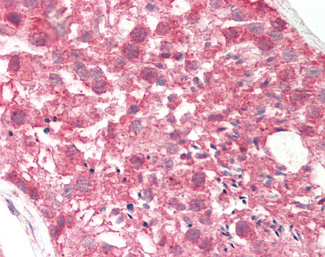OASL Antibody (N-Terminus)
Rabbit Polyclonal Antibody
- SPECIFICATION
- CITATIONS
- PROTOCOLS
- BACKGROUND

Application
| WB, IHC-P, IF, ICC, E |
|---|---|
| Primary Accession | Q15646 |
| Other Accession | 8638 |
| Reactivity | Human, Mouse, Rat |
| Host | Rabbit |
| Clonality | Polyclonal |
| Calculated MW | 59226 Da |
| Dilution | ICC (2.5 µg/ml), IF (20 µg/ml), IHC-P (10 µg/ml), WB (1 - 2 µg/ml), |
| Gene ID | 8638 |
|---|---|
| Other Names | OASL, 2-5-OAS-related protein, 2-5-OAS-RP, p59-OASL, p59OASL, TR-interacting protein 14, TRIP-14, TRIP14, OASLd, p59 OASL |
| Target/Specificity | OASL antibody is human, mouse and rat reactive. |
| Reconstitution & Storage | PBS, 0.02% sodium azide. Long term: -20°C; Short term: +4°C. Avoid repeat freeze-thaw cycles. |
| Precautions | OASL Antibody (N-Terminus) is for research use only and not for use in diagnostic or therapeutic procedures. |
| Name | OASL |
|---|---|
| Synonyms | TRIP14 |
| Function | Does not have 2'-5'-OAS activity, but can bind double- stranded RNA. Displays antiviral activity against encephalomyocarditis virus (EMCV) and hepatitis C virus (HCV) via an alternative antiviral pathway independent of RNase L. |
| Cellular Location | [Isoform p56]: Nucleus, nucleolus. Cytoplasm. |
| Tissue Location | Expressed in most tissues, with the highest levels in primary blood Leukocytes and other hematopoietic system tissues, colon, stomach and to some extent in testis |

Thousands of laboratories across the world have published research that depended on the performance of antibodies from Abcepta to advance their research. Check out links to articles that cite our products in major peer-reviewed journals, organized by research category.
info@abcepta.com, and receive a free "I Love Antibodies" mug.
Provided below are standard protocols that you may find useful for product applications.
Background
Does not have 2'-5'-OAS activity, but can bind double- stranded RNA. Displays antiviral activity against encephalomyocarditis virus (EMCV) and hepatitis C virus (HCV) via an alternative antiviral pathway independent of RNase L.
References
Hartmann R.,et al.Nucleic Acids Res. 26:4121-4127(1998).
Rebouillat D.,et al.Eur. J. Biochem. 257:319-330(1998).
Guo X.,et al.Int. J. Biochem. Cell Biol. 44:1133-1138(2012).
Ota T.,et al.Nat. Genet. 36:40-45(2004).
Scherer S.E.,et al.Nature 440:346-351(2006).
If you have used an Abcepta product and would like to share how it has performed, please click on the "Submit Review" button and provide the requested information. Our staff will examine and post your review and contact you if needed.
If you have any additional inquiries please email technical services at tech@abcepta.com.













 Foundational characteristics of cancer include proliferation, angiogenesis, migration, evasion of apoptosis, and cellular immortality. Find key markers for these cellular processes and antibodies to detect them.
Foundational characteristics of cancer include proliferation, angiogenesis, migration, evasion of apoptosis, and cellular immortality. Find key markers for these cellular processes and antibodies to detect them. The SUMOplot™ Analysis Program predicts and scores sumoylation sites in your protein. SUMOylation is a post-translational modification involved in various cellular processes, such as nuclear-cytosolic transport, transcriptional regulation, apoptosis, protein stability, response to stress, and progression through the cell cycle.
The SUMOplot™ Analysis Program predicts and scores sumoylation sites in your protein. SUMOylation is a post-translational modification involved in various cellular processes, such as nuclear-cytosolic transport, transcriptional regulation, apoptosis, protein stability, response to stress, and progression through the cell cycle. The Autophagy Receptor Motif Plotter predicts and scores autophagy receptor binding sites in your protein. Identifying proteins connected to this pathway is critical to understanding the role of autophagy in physiological as well as pathological processes such as development, differentiation, neurodegenerative diseases, stress, infection, and cancer.
The Autophagy Receptor Motif Plotter predicts and scores autophagy receptor binding sites in your protein. Identifying proteins connected to this pathway is critical to understanding the role of autophagy in physiological as well as pathological processes such as development, differentiation, neurodegenerative diseases, stress, infection, and cancer.


